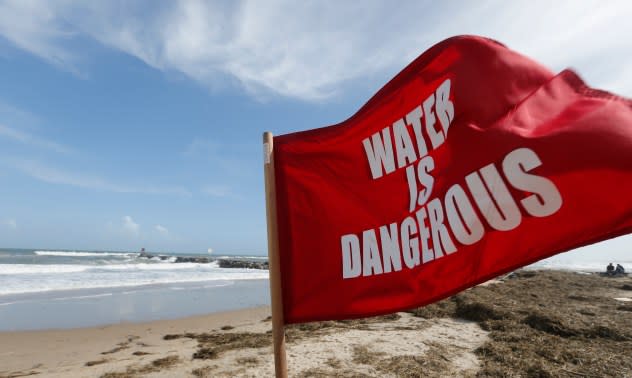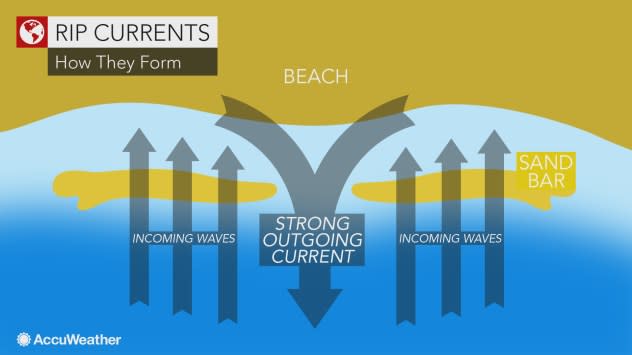Rip currents account for more than 80% of beach rescues, but what are they?
The number one threat to beachgoers is not sharks, jellyfish, or any undersea creature. In fact, the greatest threat comes from the water itself.
Rip currents, which can unexpectedly pull beachgoers out to sea, account for nearly 80% of all lifeguard rescues, according to the United States Lifesaving Association. But what is exactly is a rip current, how do they form, and how can beachgoers escape their potentially deadly grasp?
 |
Fort Lauderdale Ocean Rescue lifeguard Tom Frezza, right, and an unidentified man help Gina Rebelo, center, of Toronto, Canada, after she was caught up in a rip current, Tuesday, May 13, 2014. (AP Photo) |
What are rip currents?
Rip currents are a channel of water that can pull swimmers away from shore and farther out into the ocean. More than 100 people a year are killed by rip currents, according to the United States Lifesaving Association.
Rip currents can vary in their width and their strength. The currents can be extremely narrow, between 10 and 20 feet wide, or more than 10 times that width, according to the National Weather Service (NWS). They can also pull people out to sea at speeds higher than 5 miles per hour, which is faster than Olympic swimmers.
What causes rip currents?
"Rip currents are caused by large swells that propagate toward coastal areas," AccuWeather Senior Meteorologist Dan Kottlowski said.
Chaotic swells are stirred by powerful storms, high winds and strong circulation, which increase the volume of water in coastal areas, Kottlowski added.
Rip currents can occur at any time of the year, even on sunny days, where the hazards that stir up rip currents are well offshore. Beachgoers should pay attention to posted beach flags, which will warn of ocean hazards year-round.
 |
A warning flag flies from a lifeguard's vehicle as he patrols the beach during a break in the rain and wind storms in Virginia Beach, Virginia, on Saturday, Sept. 3, 2015. (AP Photo/Steve Helber) |
"Every area is different," Kottlowski said, referring to natural protecting barriers that mitigate rip currents in some places. Other areas may see the full force of a nearby storm.
According to the NWS, rip currents commonly form at low spots or breaks in sandbars and also near man-made structures like groins, jetties and piers.
Rip currents are not just an ocean phenomenon, either. Rip currents can form at any beach with breaking waves, including places like the Great Lakes.
 |
How to stay safe from rip currents
One important way to stay protected against rip currents is to always swim with a lifeguard present. According to the United States Lifesaving Association, the risk of death while swimming with a lifeguard present is 1 in 18 million.
If trapped in the grip of a powerful rip current, swimmers should not panic and try to swim back toward shore. The force of a rip current can exhaust even the best swimmers.
If caught in a rip current, it is best to swim parallel to shore until free of its influence.
"You cannot fight that volume of water going out," Kottlowski said. "It's impossible. People who get caught, panic, but it is best to stay calm and let the water calm down and you'll be fine."
After swimming parallel to the coast for about 50 to 100 yards, a trapped swimmer should begin swimming on an angle, away from the rip current and toward the shore.
If swimming parallel to the shore does not work, The United States Lifesaving Association recommends calmly treading water and waiting out the current until it's possible to swim safely back to shore.
If it's impossible to reach the shoreline, a trapped swimmer should draw as much attention as possible to alert a lifeguard or onlooker who can get assistance.
Kottlowski also stressed the importance of being aware of potential dangers by checking NOAA forecasts for any warnings and alerts as well as with local officials before venturing into the surf.
"You should never go in by yourself," he said. "Each beach is different."
For more safety and preparedness tips, visit AccuWeather.com/Ready.



